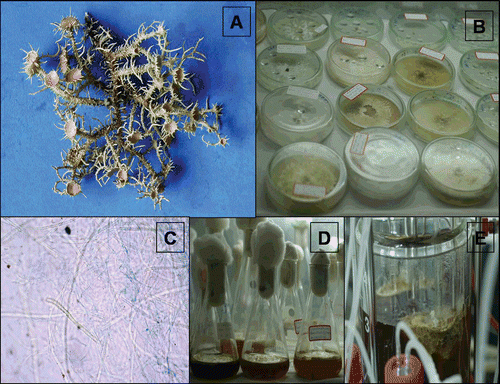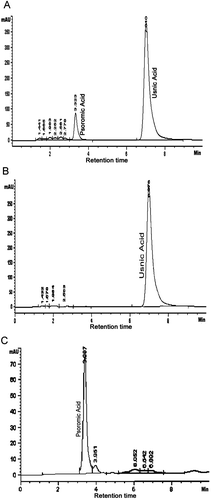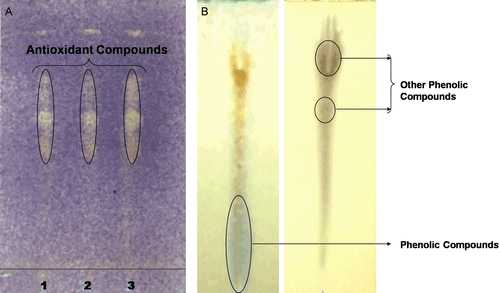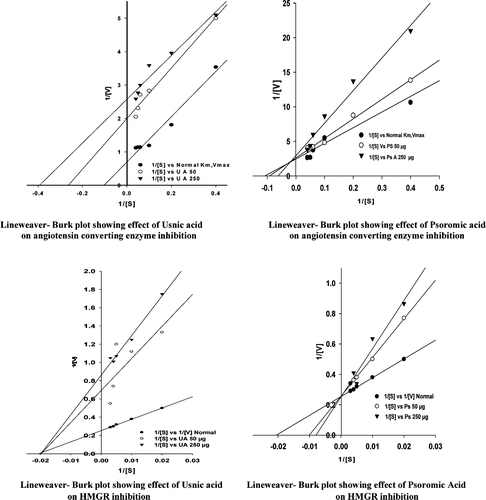Figures & data
Figure 1. A: Natural thallus of lichen Usnea complanata. B: 90-day-old culture cell derived from natural thallus fragments. C: Cells composed of blue colored fungal hyphae and dark green algal cells (micropreparation from the same culture). D: Culture in the conical flask containing liquid MY medium. E: Fermentation of cells derived from thallus.

Figure 2. A: HPLC chromatogram showing production of usnic acid and psoromic acid in the three month old symbiont culture of U. complanata. B: HPLC chromatogram of purified usnic acid from in vitro cultured lichen U. complanata. C: HPLC chromatogram of purified psoromic acid from in vitro cultured lichen U. complanata.

Figure 3. A: Yellow colored spot developed after spraying DPPH solution indicates presence of antioxidant compound in the extract of cultured lichen U. complanata. Spot 1: Ethanol extract, 2: acetone extract, 3: ethyl acetate extract. B: Identification type of phenolic group present in the cultured acetone extract of U. complanata symbiont.

Table 1. Antioxidant activity in terms of FRSA, NORSA and LPI with various concentrations of extracts of cultured lichen.
Table 2. IC50 values in μg of the cultured lichen U. complanata extract for FRSA, NORSA and LPI.
Table 3. Antioxidant activity in terms of FRSA, NORSA and LPI activities of lichen metabolites usnic acid and psoromic acid developed from lichen U. complanata in vitro culture.
Table 4. IC50 value in mg/mL of purified lichen metabolites usnic acid and psoromic acid from in vitro cultured lichen U. complanata for their antioxidant activity in terms of FRSA, NORSA and LPI.
Table 5. HMGR inhibition by the solvent extract of in vitro cultured lichen U. complanata in the presence of 200 μM concentration of HMG-COA substrate.
Table 6. ACE inhibition by different solvent extract of in vitro cultured lichen U. complanata in the presence of substrate HHL at a concentration 10 mM.
Table 7. Enzyme kinetics for inhibition of ACE and HMG-CoA reductase enzyme by the lichen acids developed in vitro and their Vmax and Km values.
Figure 4. Lineweaver-Burk plots were drawn from assays using a range of lichen metabolite (inhibitor i.e. usnic and psoromic acid) at concentrations (0, 50, 250 µg/ml) with various substrate HMG-CoA concentrations (50, 100, 200, 250 and 300 mM) for HMGR and substrate HHL at concentration of 2.5, 5.0, 10, 15, 20 and 25 mM for ACE inhibitition.

Table 8. Fibrinolytic activity in terms of zone of hydrolysis of fibrinogen in the presence of lichen metabolites purified from the in vitro cultured lichen U. complanata.
Table 9. Polyphenol and polysaccharide content in the 100 μg of in vitro cultured U. complanata extract.
Table 10. Incubation stability of the lichen metabolites isolated and purified from in vitro cultured lichen U. complanata measured antioxidative activity in terms of LPI.